One of the amusements a garden can provide is watching the birds, bees, butterflies and other critters drawn to it. Most of us have seen honeybees flying from flower to flower, sipping nectar or collecting pollen to take back to their colony. Honeybees, however, are not native to the western hemisphere. They originated in Eurasia and Africa and were imported to North America by immigrants in the 17th century. Before that time, pollination services for both wild and cultivated plants were provided by a host of native bees. There are about 4000 different species of bees native to the United States, and 1600 of those species are found in California. Most of these bees are solitary with each female making her own nest; most often the nests are in the ground, but some bee species nest above ground.
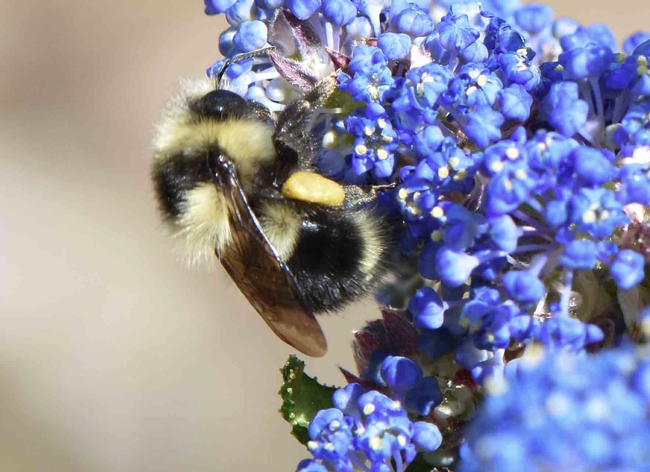
Bumble bees are one group of native bees. The body of a bumble bee generally has lots of black hair with contrasting bands of yellow, red, or white. Different species have different color patterns. Bumble bees are as large as or larger than honeybees. Female honeybee and bumble bee workers both have pollen baskets on their hind legs, which they use to carry the pollen they collect. A pollen basket is a shallow depression in the leg surrounded by a fringe of long hairs. Workers and males are similar in size, but queens are much larger. Both queens and workers have stingers, but they are not aggressive and rarely sting. Males don't have stingers.
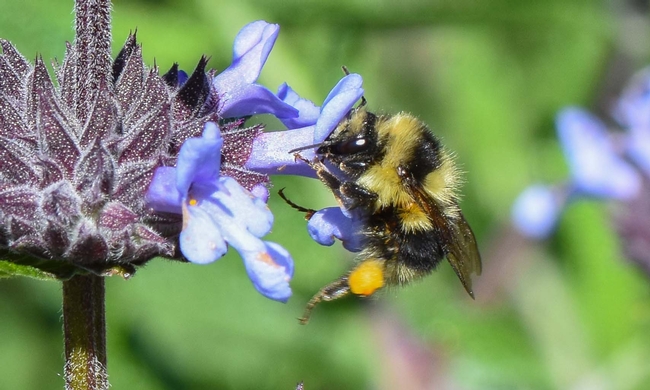
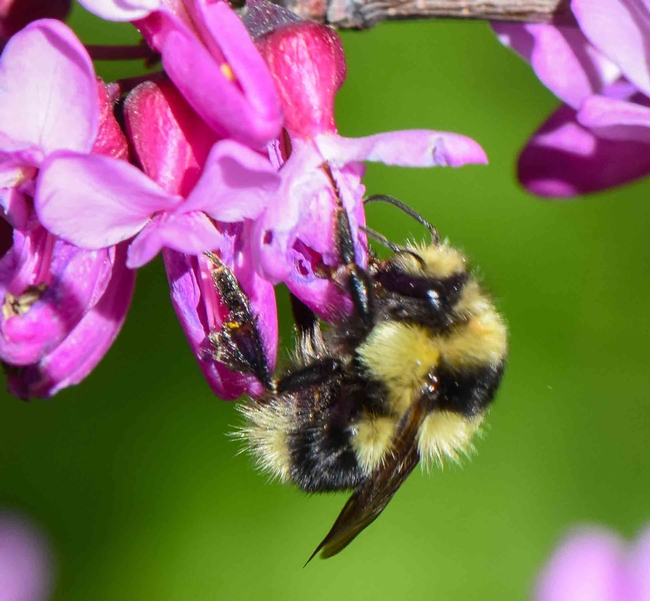
When the workers become adults, they take over foraging for nectar and pollen. The queen remains in the nest to lay more eggs as the colony grows and develops.
In late summer,some of the fertilized eggs are fed more frequently and longer than usual. These develop into new queens. The queen also lays some unfertilized eggs that will develop into male bees. Once they leave the colony, the males forage to feed themselves but don't return to the nest. They spend their days eating and searching for new queens to fertilize. At night they sleep in trees or shrubbery. In the fall the old queen, workers and males all die. Each new queen hibernates separately in a cavity in the ground until it is time for her to emerge the following year to begin her own colony.
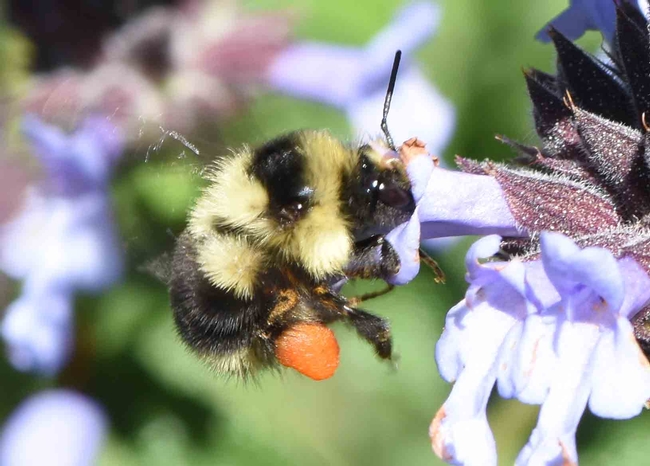
As a bumble bee moves around inside the flower, pollen collects on her hair; she uses her legs to transfer the pollen to the pollen basket. Some flowers have pollen that is contained within tubular anthers that open only at one end or through a narrow slit on the side. These anthers must be vibrated or shaken to release the pollen through the opening. Plants that function in this way include some common garden vegetables like tomatoes, eggplants, potatoes and peppers, as well as native plants like shooting stars and manzanita. Bumble bees (along with a few other bee species, but not honeybees) have evolved a specialized method called buzz pollination to obtain pollen from these plants. Bumble bees grasp the tubular anthers while vibrating their flight muscles without moving their wings. The vibration shakes the pollen loose, and it falls onto the bumble bee. Having bumble bees in your garden can increase the yield of these crops.
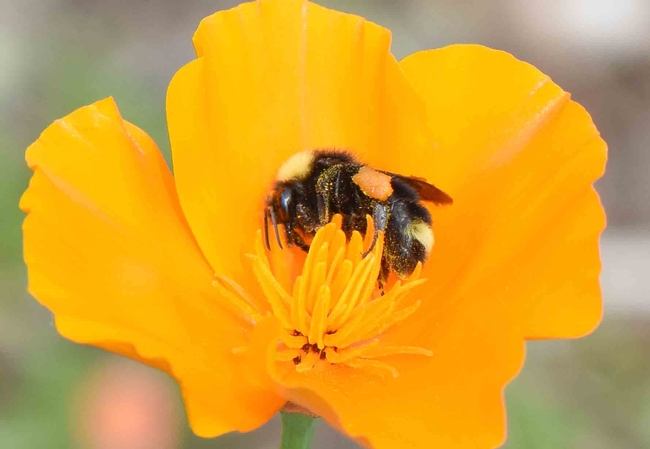
Some insects superficially resemble bumblebees, but if you look closely, you can tell the difference. Carpenter bees have bodies that are mostly black and shiny with far less hair than bumble bees. The Valley Carpenter Bee is enormous, about one inch long, much larger than a bumble bee. The females are shiny black, and the males are fuzzy golden yellow with green eyes. Syrphid flies have abdomens that are striped black and yellow, but flies have only two wings and antennae that are short and stubby. Clearwing sphinx moths are yellow and black but larger than bumble bees. They hover in front of a flower, rather than landing on it, and their antennae are long and feathery.
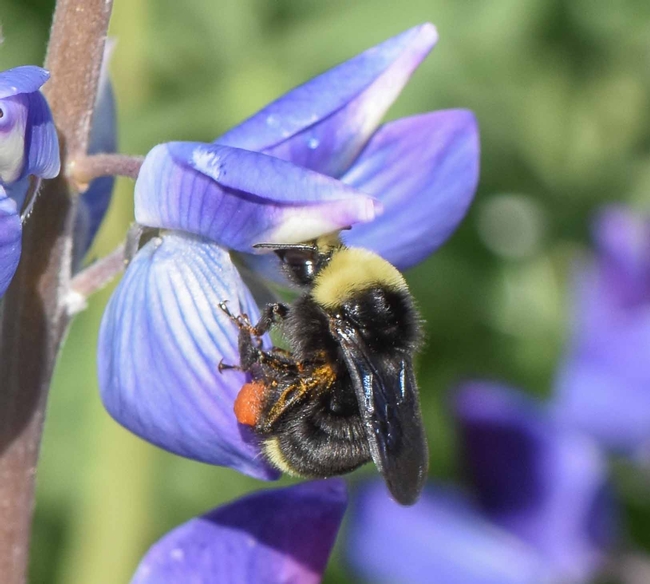
Upcoming opportunity to learn more about bumble bees: John Whittlesey, owner of Canyon Creek Nursery and Design, will be presenting “Living with Bumble Bees” online on Wednesday, April 7 at 7pm during the general meeting of the Mount Lassen Chapter of the California Native Plant Society. This meeting is free and open to the public. Go to the chapter website and click on the program title to access the link to the Zoom meeting.
The Master Gardeners Spring Workshop Series has begun. Topics include: Diagnosing Plant Problems; Mason Bees; and Native Gardens. Others will be added soon. Visit our workshop webpage to read about these upcoming free workshops and to register (required).
UC Master Gardeners of Butte County are part of the University of California Cooperative Extension (UCCE) system. To learn more about us and our upcoming events, and for help with gardening in our area, visit our website. If you have a gardening question or problem, email the Hotline at mgbutte@ucanr.edu (preferred) or call (530) 538-7201.